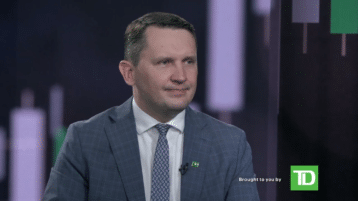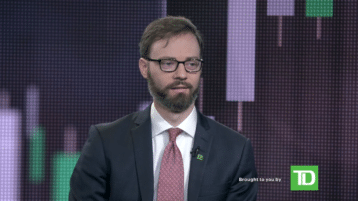The most recent U.S. employment report showed employers pulling back on their hiring last month. The results were welcomed by markets looking for signals of a potential interest rate cut. James Marple, Senior Economist at TD, discusses what the data means for the U.S. economy.
Print Transcript
[AUDIO LOGO]
Well, markets are starting the week on a positive note as a weaker than expected US jobs report has raised hopes for a Federal Reserve rate cut. Joining us now to discuss is James Marple, Senior Economist with TD. And James, thanks very much for joining us.
And of course, what's been in the news is the US jobs report. What's your reaction to the latest report?
Well, it was really a Goldilocks report. It came in at 175,000, which is really not a terrible number, but as mentioned, we had seen expectations for 240,000. So it came in a bit below that. But even elsewhere in the report you saw that wage growth, which obviously given some of the inflation metrics and the Fed's attention to inflation, came in a bit soft. So slowing on both the monthly number and the year-on-year metric came in below 3%. So, you know, that's another positive.
The unemployment rate edged up ever so slightly. It went to 3.9% from 3.8%, but actually to the second decimal place, like, it was a very minor, minor move.
It's still in a historical low.
Absolutely. I mean, it's been below 4% for over 18 months. So it's pretty stable there. You saw a slowing in the rate of job growth in the household survey, but still a positive number, but it was below the rate of growth of the labor force. So just edging the unemployment rate higher.
So I'd say pretty good all around. Obviously, signs of slowing jobs, but this came after a whopping 315,000 jobs in March, which was actually revised up. It was originally reported at 303. Upward revisions. A little bit lower in January.
But some slowdown I think was necessary. Came a little bit more than expected, but obviously not to the point where you'd be worried that the economy is in any kind of health issue. But again, yeah, I mean, for the Fed who's paying some attention to the employment side of their mandate, seeing a bit of slowing, seeing a bit of slowing on the wage growth, I think, should help them to have the confidence that they can eventually start easing policy.
I want to talk about expectations because you say that jobs growth expectations have been coming up. What does that report mean for the trend?
Sure. Well, it is interesting because if you look at what the six-month moving average was at the second half of last year, it was actually just above what this report came in at. It was about 180,000. And of course, every month almost you saw jobs come in higher than that. I think the average was something like 210,000 over of the second half.
And then over the course of this year, the first three months of this year, you saw those expectations start to move higher, actually inching toward the average in the second half of last year, and again, blown out of the water. We had 275,000 jobs over the course of this year on average. So, you know, you've seen this sort of consistent beat on the upside and I think that really showed up in what was the 240,000 last month, and so disappointed.
And I think what we'll see going forward is that we'll start to see a more sustainable rate of growth in terms of job growth and expectations should follow that down. But nothing wrong with 175,000 jobs. Our forecast is that we actually even come a little bit lower than that. The economy needs that rebalancing. And obviously, as interest rate policy does slow the economy a bit, but 150,000, even at 150,000 jobs a month, you're not really seeing the unemployment rate move any higher. You're just keeping pace with that underlying labor force growth. So that really is, I mean, a Goldilocks scenario.
OK, and staying with the US labor market, you've been focused on what we've been seeing in productivity in the United States. What's happening there because I mean, the US reading has been one of the strongest growing advanced economies since the pandemic. So tell us a little bit about the trends that you're seeing there.
Sure. Well, it really stands out when you compare the US to all of its peers. We've seen the US is the only country that has seen labor productivity accelerate relative to its decade-long trend prior to the pandemic. It's grown at about 1.5% in the four years, including the pandemic period. And it grew about 1% prior.
You compare that to Canada, where we were very similar to the US on average over the decade prior to the pandemic, but since then have seen, actually, we have negative productivity growth in Canada since the pandemic. All of the economic growth has been accounted for by increasing employment and labor hours.
Europe's in a similar state where it's seen very moribund productivity growth. The UK has done a bit better, but the UK stands out as just having the weakest overall economic performance relative to all of its peers. So what really stands out is just how different the US is from everyone else. And we're seeing that now in terms of expectations for policy, but also even just the exchange rate where the US has really outperformed all of its peers.
I think there is a question about how sustainable that recent rate of growth is. And we did have data just came out last week for the first quarter and there was a noticeable slowdown in the rate of US productivity growth, but still on a year-on-year basis, running at 2.9%, which is just fantastic. And supporting, obviously, that rate of economic growth.
So I'd say probably going to slow, but still at a level well above everyone else. And maybe with the adoption of more artificial intelligence, large language models, we could see potentially a higher sustained rate of productivity growth. Although I think that may take a bit longer to play out than what we're seeing in the here and now.
OK, so given all that, what's your outlook on inflation and interest rates going forward?
Sure. Well, let's start with the US. In the US, inflation really has been stickier, especially over the first three months. So we surprised on the upside on the jobs. We also surprised on the inflation numbers. I think we will see inflation likely over the course of this year, just the arithmetic in terms of what the Fed is looking at, which is that core PCE metric, the price index on personal consumption, likely remain pretty close to that 3% mark. And that just reflects some of just the way the data has come in on a monthly basis and the acceleration we saw at the start of this year.
Well, what that means for interest rates is it means it's probably going to take longer for the Fed to have the confidence that it can start normalizing policy. So the Fed funds rate's at 5 and 1/2%. We don't think they'll be cutting until December of this year and probably just one 25 basis point cut.
And then over the course of 2025, I think we do get that improvement in inflation or movement more toward 2% slowing in inflation, and that should allow them to pick up the pace of rate cuts and probably get to a stage where they're cutting by 25 basis points a month. And that should allow them to get to a Fed funds rate right now where we're at 5 and 1/2, and they eventually get to 3 and 1/2. But it's going to take till the end of next year.
Canada, the story is a little bit different. Obviously, the economy's been weakening. Inflation headline is at 2.9%, but if you look under the surface, some of the Bank of Canada's core measures have really slowed, especially on a three-month moving average or six-month moving average, so more recently. And the economy's only growing by 1%.
The unemployment rate has moved noticeably higher in Canada, it's at 6.1%. It was more than a percentage point lower than that at its trough in mid 2022. So that means that the Bank of Canada probably going to cut before the Fed. We think likely by July is when we'll get that first Bank of Canada cut.
And then a cadence that they may not cut every meeting because looking at what the Fed's doing, but we probably get a few more cuts by the end of this year. And then again in 2025, maintaining that cadence. So we're, we think, at the start of rate cuts and a little bit closer in Canada relative to the US.
And sticking with Canada, of course, we have our jobs report coming out this Friday. What are you expecting?
Well, we saw a pretty poor jobs number. I mean, 2.2 or just over 2,000 jobs lost in March. And for April, we think we may move to a positive number, but very modest. I mean, there's a lot of volatility in the Canadian monthly job number, but I think the underlying story is, job growth slower than the rate of labor force growth and probably some continued upward movement in the unemployment rate. May not happen in April because it actually jumped a fair bit in March, but I think the general trend will be continued of the slowing economy coming out in the labor market and gradually pushing that unemployment rate a bit higher.
[AUDIO LOGO]
[UPBEAT MUSIC]
[AUDIO LOGO]
Well, markets are starting the week on a positive note as a weaker than expected US jobs report has raised hopes for a Federal Reserve rate cut. Joining us now to discuss is James Marple, Senior Economist with TD. And James, thanks very much for joining us.
And of course, what's been in the news is the US jobs report. What's your reaction to the latest report?
Well, it was really a Goldilocks report. It came in at 175,000, which is really not a terrible number, but as mentioned, we had seen expectations for 240,000. So it came in a bit below that. But even elsewhere in the report you saw that wage growth, which obviously given some of the inflation metrics and the Fed's attention to inflation, came in a bit soft. So slowing on both the monthly number and the year-on-year metric came in below 3%. So, you know, that's another positive.
The unemployment rate edged up ever so slightly. It went to 3.9% from 3.8%, but actually to the second decimal place, like, it was a very minor, minor move.
It's still in a historical low.
Absolutely. I mean, it's been below 4% for over 18 months. So it's pretty stable there. You saw a slowing in the rate of job growth in the household survey, but still a positive number, but it was below the rate of growth of the labor force. So just edging the unemployment rate higher.
So I'd say pretty good all around. Obviously, signs of slowing jobs, but this came after a whopping 315,000 jobs in March, which was actually revised up. It was originally reported at 303. Upward revisions. A little bit lower in January.
But some slowdown I think was necessary. Came a little bit more than expected, but obviously not to the point where you'd be worried that the economy is in any kind of health issue. But again, yeah, I mean, for the Fed who's paying some attention to the employment side of their mandate, seeing a bit of slowing, seeing a bit of slowing on the wage growth, I think, should help them to have the confidence that they can eventually start easing policy.
I want to talk about expectations because you say that jobs growth expectations have been coming up. What does that report mean for the trend?
Sure. Well, it is interesting because if you look at what the six-month moving average was at the second half of last year, it was actually just above what this report came in at. It was about 180,000. And of course, every month almost you saw jobs come in higher than that. I think the average was something like 210,000 over of the second half.
And then over the course of this year, the first three months of this year, you saw those expectations start to move higher, actually inching toward the average in the second half of last year, and again, blown out of the water. We had 275,000 jobs over the course of this year on average. So, you know, you've seen this sort of consistent beat on the upside and I think that really showed up in what was the 240,000 last month, and so disappointed.
And I think what we'll see going forward is that we'll start to see a more sustainable rate of growth in terms of job growth and expectations should follow that down. But nothing wrong with 175,000 jobs. Our forecast is that we actually even come a little bit lower than that. The economy needs that rebalancing. And obviously, as interest rate policy does slow the economy a bit, but 150,000, even at 150,000 jobs a month, you're not really seeing the unemployment rate move any higher. You're just keeping pace with that underlying labor force growth. So that really is, I mean, a Goldilocks scenario.
OK, and staying with the US labor market, you've been focused on what we've been seeing in productivity in the United States. What's happening there because I mean, the US reading has been one of the strongest growing advanced economies since the pandemic. So tell us a little bit about the trends that you're seeing there.
Sure. Well, it really stands out when you compare the US to all of its peers. We've seen the US is the only country that has seen labor productivity accelerate relative to its decade-long trend prior to the pandemic. It's grown at about 1.5% in the four years, including the pandemic period. And it grew about 1% prior.
You compare that to Canada, where we were very similar to the US on average over the decade prior to the pandemic, but since then have seen, actually, we have negative productivity growth in Canada since the pandemic. All of the economic growth has been accounted for by increasing employment and labor hours.
Europe's in a similar state where it's seen very moribund productivity growth. The UK has done a bit better, but the UK stands out as just having the weakest overall economic performance relative to all of its peers. So what really stands out is just how different the US is from everyone else. And we're seeing that now in terms of expectations for policy, but also even just the exchange rate where the US has really outperformed all of its peers.
I think there is a question about how sustainable that recent rate of growth is. And we did have data just came out last week for the first quarter and there was a noticeable slowdown in the rate of US productivity growth, but still on a year-on-year basis, running at 2.9%, which is just fantastic. And supporting, obviously, that rate of economic growth.
So I'd say probably going to slow, but still at a level well above everyone else. And maybe with the adoption of more artificial intelligence, large language models, we could see potentially a higher sustained rate of productivity growth. Although I think that may take a bit longer to play out than what we're seeing in the here and now.
OK, so given all that, what's your outlook on inflation and interest rates going forward?
Sure. Well, let's start with the US. In the US, inflation really has been stickier, especially over the first three months. So we surprised on the upside on the jobs. We also surprised on the inflation numbers. I think we will see inflation likely over the course of this year, just the arithmetic in terms of what the Fed is looking at, which is that core PCE metric, the price index on personal consumption, likely remain pretty close to that 3% mark. And that just reflects some of just the way the data has come in on a monthly basis and the acceleration we saw at the start of this year.
Well, what that means for interest rates is it means it's probably going to take longer for the Fed to have the confidence that it can start normalizing policy. So the Fed funds rate's at 5 and 1/2%. We don't think they'll be cutting until December of this year and probably just one 25 basis point cut.
And then over the course of 2025, I think we do get that improvement in inflation or movement more toward 2% slowing in inflation, and that should allow them to pick up the pace of rate cuts and probably get to a stage where they're cutting by 25 basis points a month. And that should allow them to get to a Fed funds rate right now where we're at 5 and 1/2, and they eventually get to 3 and 1/2. But it's going to take till the end of next year.
Canada, the story is a little bit different. Obviously, the economy's been weakening. Inflation headline is at 2.9%, but if you look under the surface, some of the Bank of Canada's core measures have really slowed, especially on a three-month moving average or six-month moving average, so more recently. And the economy's only growing by 1%.
The unemployment rate has moved noticeably higher in Canada, it's at 6.1%. It was more than a percentage point lower than that at its trough in mid 2022. So that means that the Bank of Canada probably going to cut before the Fed. We think likely by July is when we'll get that first Bank of Canada cut.
And then a cadence that they may not cut every meeting because looking at what the Fed's doing, but we probably get a few more cuts by the end of this year. And then again in 2025, maintaining that cadence. So we're, we think, at the start of rate cuts and a little bit closer in Canada relative to the US.
And sticking with Canada, of course, we have our jobs report coming out this Friday. What are you expecting?
Well, we saw a pretty poor jobs number. I mean, 2.2 or just over 2,000 jobs lost in March. And for April, we think we may move to a positive number, but very modest. I mean, there's a lot of volatility in the Canadian monthly job number, but I think the underlying story is, job growth slower than the rate of labor force growth and probably some continued upward movement in the unemployment rate. May not happen in April because it actually jumped a fair bit in March, but I think the general trend will be continued of the slowing economy coming out in the labor market and gradually pushing that unemployment rate a bit higher.
[AUDIO LOGO]
[UPBEAT MUSIC]



























